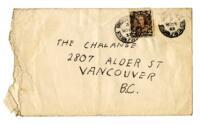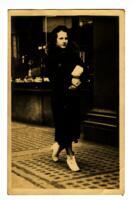The John Vance Fonds contains records related to the personal and professional activities of John Vance as a City Analyst and forensics investigator for the Vancouver Police Department. The records include both personal and professional correspondence, reports, working notes and calculations, research notes, investigation files, photographs, certificates, newspaper clippings and magazines. From 1907 until 1949 Vance worked for the City of Vancouver as the City Analyst. His chemistry background was put to use testing a wide range of commercial food products; samples of cement, asphalt and road oils for quality and durability; and regular analysis of water from Capilano Canyon and Seymour Creek to ensure it was safe to drink. As his career progressed, Vance would later be appointed to the role of Provincial Analyst and Dominion Analyst. Like many of his neighbours, Vance was ardent about enlisting in the war effort. In 1914 he joined the Vancouver Volunteer Reserve as a Platoon Sergeant. He would spend the next two years trying to get permission from the City of Vancouver to join troops overseas but they would not grant him permission, citing that he was an invaluable and irreplaceable employee. In 1914 Vance entered the world of forensics when he was asked by the Vancouver Police Department to analyze blood samples from a crime scene. His methodical nature and detailed analysis quickly made him an asset to the VPD. A small laboratory was set up in the police department and his expertise and unique skill set was frequently relied upon to help solve murders, crimes, and other investigations. He was regularly called upon to testify in court and worked with the RCMP and other police jurisdictions throughout the province. In 1932 Vance was appointed Honorary Inspector of the Police Department in charge of the Police Bureau of Science. That same year, a purpose-built City Analyst’s laboratory opened at 238 East Cordova Avenue, Vancouver. The laboratory was one of the largest and best equipped police science laboratories in North America until it closed down in 1996. If a piece of equipment didn’t exist that he needed, Vance invented it. In the 1930s he developed an ultra-violet ray machine that could be used to detect drugs, bodily fluids and counterfeit money. He also invented the Vancamoscope, a ‘robot nose’ that he believed could identify suspected persons by their scent. Throughout his career, local newspapers often reported upon Vance’s scientific approach to crime-fighting. International media dubbed him “Canada’s Sherlock Holmes” and several true crime magazines included stories on him, written in sensational fashion. In 1934 Vance’s reputation caught up with him during a series of investigations that led to seven attempts on his life including threatening letters, a car bomb, a bomb placed at his home, and an attack where he was ambushed in his garage and acid was thrown at him. During this time Vance and his family were under 24/7 police guard. In addition to his work with the police, Vance maintained his regular daily work as the City Analyst and Chief Food and Dairy Inspector. He continued to test water, milk and other food items for their purity and quality. He also tested the alcohol content of bootleg liquor and presented his findings as evidence in court. He also completed toxicology work for the City of Vancouver Morgue. In 1939 Vance was given the role of the “Royal Analyst” and put in charge of inspecting everything that would be eaten during the royal visit of King George VI and Queen Elizabeth while in B.C. After a long and dynamic career, John Vance retired on April 6, 1949 at the age of 65 years old. Vance passed away on September 21, 1964 at the age of 80 years old and is buried at the Mountain View Cemetery in Vancouver, B.C. The John Vance Fonds has been arranged into the following record series: Series 1: Personal and Professional Correspondence Series 2: Vance Reference Files Series 3: Investigation and Working Files Series 4: Publications The digitization of these records was generously supported by project funding from the Irving K. Barber Learning Centre’s BC History Digitization Program. For research inquiries, please contact archives@vancouverpolicemuseum.ca.




